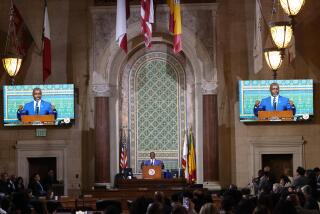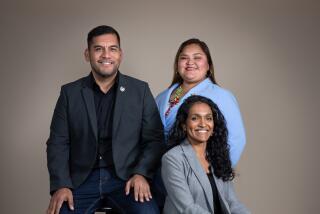Growth Issue: Flashpoint in New Struggles for City Power
The polls have closed. The election is over. Now, on the Los Angeles City Council, the real voting begins.
Flush from recent election victories, supporters of the city’s slow-growth movement on the council believe they have the strength for the first time to change priorities at City Hall.
A first order of business will be to select a replacement for Council President Pat Russell, ousted by Ruth Galanter in the June 2 runoff. The preference of the slow-growth coalition is veteran Councilwoman Joy Picus.
Galanter, who takes office July 1, embodies the latest success for the slow-growthers, who won passage last year of Proposition U, which restricts high-rise construction in residential neighborhoods.
Spurred by that success, the slow-growth advocates next want to go a step further. They have outlined a new legislative effort to further limit large-scale development in the city, along with a warning that if it is not passed this summer, their supporters will try to qualify a ballot measure.
“No question about it,” said Councilman Marvin Braude, one of those pushing the new legislation. “There is a window of opportunity this summer for elected officials to demonstrate if they are in tune with what the people want.”
“It’s full speed ahead for the movement,” said Councilman Zev Yaroslavsky, Braude’s ally and an expected candidate against Mayor Tom Bradley in 1989. They were co-authors of Proposition U, which has been hailed as the first sign of the slow-growth movement here.
Galanter did not give supporters of slow growth a majority on the 15-member City Council. But its numbers have grown enough to threaten a pro-development bloc that has dominated the council but has been steadily losing members through resignations, election losses and the death of one councilman, Howard Finn.
Today, developers of large commercial buildings can generally count on only six likely votes for the zoning changes and other city ordinances usually necessary for big projects. They are Richard Alatorre, Hal Bernson, Robert Farrell, John Ferraro, Joan Milke Flores and Gilbert Lindsay. When the realigned council begins work July 1, the slow-growth movement can match that lineup with their own half-dozen supporters--Picus, Braude, Yaroslavsky, Galanter, Joel Wachs and Michael Woo.
The remaining council members--Ernani Bernardi, Nate Holden and Gloria Molina--are considered swing votes because of their independence, changing constituencies or lack of voting record.
The two sides will do battle on other issues that are environmentally oriented.
For example, a law that would further restrict billboards and signs, proposed by Braude and pushed by environmentalists and homeowner groups, will be before the council in the coming months and will be fiercely fought by a billboard industry that has lobbied council members heavily in the past.
Oil Drilling Issue
Opponents of the controversial Occidental Petroleum drilling plan in the Pacific Palisades, now before the California Coastal Commission, are hopeful that the issue will return to the City Council for a possible reversal of an earlier vote supporting the drilling. Proponents say another vote is unlikely.
Major transportation concerns will include not only the routing and financing of the Metro Rail transit line but also questions of how to deal with choked streets and traffic congestion.
The council will face a trash dilemma, including the revival of a controversial proposal requiring homeowners to separate recyclable materials. Meanwhile, foes of the LANCER project, a proposed waste-to-energy plant in South-Central Los Angeles, are also heartened that a new council lineup may doom the project on grounds that it is an environmental or health risk.
And a proposal to build an underground crude oil pipeline through the city, which has infuriated some community groups, will come up later this year.
The major clash, however, is expected to erupt over land use and development.
Spotlight in Runoff
These issues were spotlighted in Galanter’s stunning victory over 17-year incumbent Russell. Galanter campaigned hard against development projects that had been championed by Russell, and she promised to seek ways to scale back four of the massive projects in her coastal district when she assumed office.
Galanter’s arrival is expected to help the proposal pushed by Braude and Yaroslavsky to require close city scrutiny of hundreds of development projects that now win automatic approval.
Dan Garcia, president of the planning commission, quickly labeled the proposal “a shotgun, poorly thought-out approach.”
“This has nothing to do with planning,” Garcia scoffed. “It’s purely a political move.”
Yaroslavsky, however, said that he expects the proposal--or a modified version--to win council approval. But in order to win, Yaroslavsky and his allies may have to buck Bradley, who favors what he calls “limited development.”
Influence of Mayor
As a popular four-term mayor with the influence and votes, Bradley has generally found the council to be a complaisant body. But that, too, has changed.
Over the last two years, a crop of more independent-minded council members has been elected--Alatorre, Molina and Woo--who not only hold less allegiance to the mayor but also have made it clear that they steer their own political course. Also gone are two principal Bradley supporters--Russell and David Cunningham, who resigned in October.
The mayor, meanwhile, has suffered other setbacks.
Already tarnished by a landslide loss for governor, Bradley found himself on the losing side of the Proposition U vote. In the June election, both his candidates lost by large margins to Galanter and Holden. And, in an unusual display of public disapproval, the mayor’s performance on the city budget and the homeless issue drew criticism from the council.
“I don’t see any clear policies coming from that office. That’s the real problem,” said Picus, a Bradley supporter who is running for council president. “Nothing is coming through clearly and with focus, direction and priority. Nothing.”
Connections Severed
Flores, who along with Ferraro and Bernson have been mentioned as council president contenders, agreed that no matter who is elected next month, the “umbilical cord” which once linked the council to the mayor’s office will be severed.
The importance of the council presidency rests largely with the 45 committee assignments that the winner will make, but the selection also may signal which direction the council is heading.
Picus, who describes herself as the candidate of the slow-growth movement, told The Times she will appoint a slow-growth advocate to head the Planning and Environment Committee and has placed the need for development restrictions high on her agenda.
But Picus, who along with Flores is the leading candidate for the job, must still persuade some slow-growth proponents that her earlier support for a large development--the Warner Center--in her own district was a rarity.
Flores, whose support comes largely from pro-development members, is widely respected in her present job as the council president pro tem. But even in a nonpartisan post, her conservative Republicanism--on a council dominated by liberal Democrats--hurts her chances as do her close ties to the development community.
Time for Trade-Offs
With a close vote expected, the presidential election could turn not only on partisanship, ideology or personality, but its outcome could also depend on trade-offs--whether for committee assignments or for choice office space at City Hall.
The speculation about which direction the council is heading has made some people jubilant, some nervous and others simply more circumspect.
“We’re delighted. I think there are some significant changes,” said Gerald Silver, president of Homeowners of Encino. “There was a broad-based distress from San Pedro to the farther reaches of the Valley that the city was not responding to residents but to special interests.”
But Silver cautioned that homeowner groups will be watching the council closely to see if the political shifts are merely temporary.
George Mihlsten, a lobbyist-lawyer who represents developers and property owners at City Hall, said the real test for the council is yet to come. “If the council shifts to no-growth or much less intense growth,” he said, “those decisions have vast implications for the financial and economic well-being of the city.”
Meanwhile, Kevin Ketchum of Center City West Associates, a business partnership that hopes to develop a portion of the Central City area in conjunction with the city, said that the new political atmosphere will result in other changes.
“I think the development community has to be more responsive to those interests that are outside the development community,” Ketchum said. “I think that’s clear from the Pat Russell referendum--the concern citizens have about their communities.”
But he added that does not mean all development will dwindle. “As long as we’re responsible,” Ketchum said, “we’re confident in the long run that we will prevail.”
More to Read
Sign up for Essential California
The most important California stories and recommendations in your inbox every morning.
You may occasionally receive promotional content from the Los Angeles Times.









